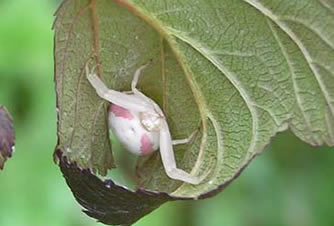

NATURE NOTES

Crab Spider, photo by Hugh Griffith
Waiting to Pounce
by
One of the great things about being a human is that you are a relatively large animal and therefore not in constant danger of being eaten by something larger. The vast majority of animals are very small and feature prominently on the menu of larger predators. What is large? Spiders are large. They are among the most successful of predators, and are pretty much everywhere.
Any house has plenty of spiders. There are cobweb spiders in the crawl space, wolf spiders in the garage, house spiders under the soffits, and jumping spiders on the windowsill. None are particularly dangerous to humans, but that is because, again, we are large. In addition, we can defend ourselves. We have the ability to convert thumb and forefinger into a powerful spring-loaded weapon. Flick.
Most insects and their tiny kin have no such skill. To them, spiders are the monsters under the bed, and everywhere else. How about bees? As insects go, bees are decidedly robust, and certainly not defenceless. A spider would have to be crazy to tangle with a bee.
Not so. One group of spiders, the crab spiders, regularly dines on bees. Instead of constructing an ensnaring web, a crab spider uses itself as a trap. It lurks where a bee might land, often directly atop a colourful flower. It splays its lengthy front legs outward like the pincers of an angry crab. When a bee lands, it grabs, a classic example of what is known as a sit-and wait predator.
Crab spiders have a couple of other neat tricks. One is that they can slowly change their body colour to match that of the flower. They can be white, or pastel shades of pink, yellow or pale green, the same palette as those dubious marshmallow things that were in Lucky Charms cereal. Some go farther, perhaps too far, mimicking bird droppings. The second trick is that their venom is particularly potent to bees, which lessens the potential for a knock-down drag-out struggle that could go the wrong way.
The crab spider in the picture was on a nine-bark bush not about to blossom for several days. Undaunted, she cleverly folded a leaf over herself and secured it with silk. There she sat, awaiting a bee. That was yesterday. I just checked again, and she waits there still.
Hugh Griffith is a BC zoologist and science writer.
Please cite these pages as:
Author, date, page title. In: Klinkenberg, Brian. (Editor) 2021. E-Fauna BC: Electronic Atlas of the Fauna of British Columbia [www.efauna.bc.ca]. Lab for Advanced Spatial Analysis, Department of Geography, University of British Columbia, Vancouver. [Date Accessed]
© Copyright 2021 E-Fauna BC.